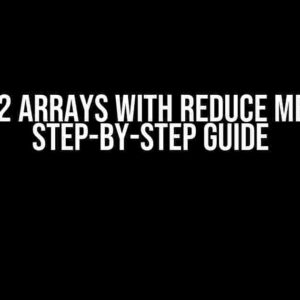Are you tired of writing complex SQL queries that make your head spin? Do you struggle to filter data efficiently using traditional methods? Look no further! In this article, we’ll delve into the powerful combination of using CASE with WHERE clause, a game-changing technique that will simplify your data manipulation and analysis tasks. Buckle up, and let’s dive into the world of SQL mastery!
What is the CASE Statement?
The CASE statement is a SQL construct that allows you to perform conditional logic within a SELECT, INSERT, UPDATE, or DELETE statement. It evaluates an expression and returns a specific value based on a set of conditions. Think of it as a switch statement in programming languages, but for your database.
CASE
WHEN condition THEN result
[WHEN condition THEN result]
...
ELSE result
END
What is the WHERE Clause?
The WHERE clause is used to filter data based on specific conditions. It’s like a gatekeeper that controls which data passes through to the next stage of processing.
SELECT *
FROM table_name
WHERE condition;
Why Use CASE with WHERE Clause?
By combining CASE with WHERE clause, you can create powerful and flexible filtering mechanisms that simplify complex data analysis tasks. This technique allows you to:
- Perform conditional filtering based on multiple criteria
- Handle NULL values with ease
- Avoid cumbersome AND, OR, and NOT operators
- Write more readable and maintainable code
Basic Syntax and Examples
The basic syntax for using CASE with WHERE clause is as follows:
SELECT *
FROM table_name
WHERE CASE
WHEN condition THEN result
[WHEN condition THEN result]
...
ELSE result
END = value;
Let’s consider a simple example to illustrate this concept:
SELECT *
FROM customers
WHERE CASE
WHEN country = 'USA' THEN 1
WHEN country = 'Canada' THEN 2
ELSE 0
END = 1;
In this example, we’re selecting all customers from the USA. The CASE statement evaluates the country column and returns 1 if it’s ‘USA’, 2 if it’s ‘Canada’, and 0 otherwise. The WHERE clause then filters the results to only include rows where the CASE statement returns 1.
Advanced Techniques and Scenarios
Now that we’ve covered the basics, let’s explore some advanced techniques and scenarios where using CASE with WHERE clause shines:
Handling NULL Values
When dealing with NULL values, traditional WHERE clauses can become unwieldy. CASE with WHERE clause comes to the rescue:
SELECT *
FROM orders
WHERE CASE
WHEN total_amount IS NULL THEN 0
ELSE total_amount
END > 100;
In this example, we’re selecting orders with a total amount greater than 100. The CASE statement handles NULL values by returning 0, ensuring that these rows are correctly filtered.
Multiple Conditions with OR Logic
What if you need to filter data based on multiple conditions with OR logic? CASE with WHERE clause makes it a breeze:
SELECT *
FROM products
WHERE CASE
WHEN category = 'Electronics' THEN 1
WHEN subcategory = 'Laptops' THEN 1
WHEN brand = 'Apple' THEN 1
ELSE 0
END = 1;
In this example, we’re selecting products that belong to the ‘Electronics’ category or have a subcategory of ‘Laptops’ or are from the ‘Apple’ brand. The CASE statement returns 1 if any of these conditions are true, and 0 otherwise.
Dynamic Filtering
Sometimes, you need to filter data based on dynamic criteria. CASE with WHERE clause can handle this scenario with ease:
SELECT *
FROM customers
WHERE CASE
WHEN @filter_type = 'country' THEN country = @filter_value
WHEN @filter_type = 'region' THEN region = @filter_value
ELSE 1 = 0
END;
In this example, we’re selecting customers based on a dynamic filter type and value. The CASE statement evaluates the filter type and applies the corresponding condition to the WHERE clause.
Best Practices and Performance Considerations
When using CASE with WHERE clause, keep the following best practices and performance considerations in mind:
- Use meaningful column aliases**: Avoid using generic aliases like ‘result’ or ‘value’. Instead, use meaningful names that describe the data being filtered.
- Optimize your CASE statement**: Keep your CASE statement concise and efficient. Avoid unnecessary conditions or calculations.
- Use indexes wisely**: Ensure that your filtered columns have appropriate indexes to improve query performance.
- Monitor query performance**: Keep an eye on query execution plans and optimize as needed to avoid performance bottlenecks.
Conclusion
Using CASE with WHERE clause is a powerful technique that simplifies complex data filtering tasks. By mastering this technique, you’ll unlock new possibilities for data analysis and manipulation. Remember to follow best practices, optimize your queries, and always keep your data in mind.
| Scenario | CASE with WHERE Clause |
|---|---|
| Conditional filtering | SELECT * FROM table_name WHERE CASE WHEN condition THEN result ELSE result END = value; |
| Handling NULL values | SELECT * FROM table_name WHERE CASE WHEN column IS NULL THEN value ELSE column END > value; |
| Multiple conditions with OR logic | SELECT * FROM table_name WHERE CASE WHEN condition THEN 1 WHEN condition THEN 1 ELSE 0 END = 1; |
| Dynamic filtering | SELECT * FROM table_name WHERE CASE WHEN @filter_type = 'condition' THEN column = @filter_value ELSE 1 = 0 END; |
Now, go forth and conquer the world of SQL with the mighty CASE statement and WHERE clause combination!
Frequently Asked Questions
Get your doubts cleared about using case with where clause!
What is the main difference between using a case statement with a where clause versus without?
The main difference is that when you use a case statement with a where clause, the case statement filters the data before the query is executed, whereas without the where clause, the case statement filters the data after the query is executed. This can greatly impact the performance and efficiency of your query!
Can I use multiple conditions in a single case statement with a where clause?
Absolutely! You can use multiple conditions in a single case statement with a where clause by separating them with the AND or OR operators. For example: CASE WHEN condition1 AND condition2 THEN result ELSE another_result END.
How do I handle null values when using a case statement with a where clause?
When dealing with null values, you can use the IS NULL or IS NOT NULL operators to check for nullity. You can also use the COALESCE function to return a default value when a column is null. For example: CASE WHEN column IS NULL THEN default_value ELSE column END.
Can I use aggregate functions with a case statement and a where clause?
Yes, you can! You can use aggregate functions like SUM, AVG, and COUNT with a case statement and a where clause. For example: SELECT SUM(CASE WHEN condition THEN value ELSE 0 END) FROM table WHERE clause.
What are some common use cases for using a case statement with a where clause?
Common use cases include data validation, data transformation, and conditional filtering. For example, you can use a case statement with a where clause to filter out invalid data, convert data types, or perform conditional aggregations.



